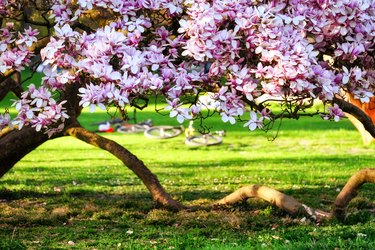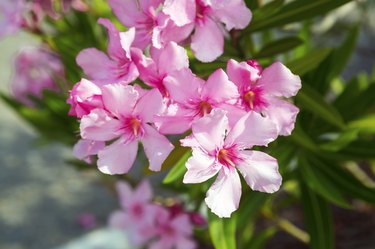
There are approximately 125 species of magnolia (Magnolia spp.). No magnolia is poisonous to dogs or cats. However, diligence is necessary when adding plants to your garden, as there are many trees and shrubs that can make Fluffy or Fido very ill. Seek medical care for your pet right away if you believe he has ingested any part of a poisonous plant.
Identifying Magnolia Trees
Video of the Day
Magnolias are associated with the Southern United States, though there are some species and cultivars that are hardy enough to grow in Northern regions. Some magnolias grow in the form of trees, and others are large shrubs. Some are evergreen, while others may be deciduous, meaning they shed their leaves in the fall. Magnolia flowers vary in size and may be white, pink and in some cases, purple. The flowers are always showy and extremely fragrant.
Video of the Day
Popular species include southern magnolia (Magnolia grandiflora), a broadleaf evergreen variety, which is usually between 60 and 80 feet tall and has enormous white flowers with a diameter between 8 and 12 inches. The star magnolia (Magnolia stellata), on the other hand, is a shrub with a height between 15 and 20 feet. The bigleaf magnolia (Magnolia macrophylla) is prized for its foliage. As its common name implies, the leaves of the species can be up to 3 feet long.
Is Magnolia Poisonous to Dogs?

Magnolia trees are not considered toxic to dogs, cats or horses. However, there are other plants you want to avoid around pets, including the sago palm, which is a species of cycad. This plant contains chemicals that are toxic to the nervous system and can cause paralysis, seizures and even death. Even just two seeds of the sago palm are extremely poisonous to animals.
Other plants you want to keep away from your pets at all costs are yews, including the Japanese yew and the English yew. These evergreen shrubs that produce red berries are poisonous not only to cats, dogs and horses but also to birds. Ingestion of any part of the plant can lead to death. Black walnut trees can also pose a danger to dogs but only if the pup consumes its moldy fruit.
Toxic Flowering Plants
Many common spring flowers that grow from bulbs are poisonous to dogs, including daffodils, tulips and hyacinth. In some cases, the bulb is more toxic than the leaves and stems. Meanwhile, the grayanotoxins found in rhododendrons and azaleas can cause gastrointestinal symptoms, like vomiting and diarrhea, and in severe cases, heart failure. If your puppy exhibits uncoordination and excessive salivation, she may have gotten into a chrysanthemum plant.

Then there is oleander. A popular choice for locations where the soil is dry and of poor quality, oleander has high levels of cardiac glycosides, which affect the heart of any pet that consumes it. Popular holiday plants, like amaryllis and mistletoe, are also toxic to pets. Keep them away from hydrangeas too.
Some plants are toxic to specific species of animals and not others. For example, while lilies are safe for dogs and horses, they cause kidney failure in cats within days.
- American Society for the Prevention of Cruelty to Animals: Magnolia Bush
- Clemson Cooperative Extension: Magnolia
- UC Davis: 10 Garden Plants That Are Toxic to Pets
- American Society for the Prevention of Cruelty to Animals: Azalea
- Missouri Botanical Garden: Magnolia grandiflora
- American Society for the Prevention of Cruelty to Animals: Lily
- Oklahoma State University: Yew and Your Animals
- American Society for the Prevention of Cruelty to Animals Pro: Oleander: Beautiful but Deadly to Pets
- University of Kentucky College of Agriculture, Food and Environment: Bigleaf Magnolia